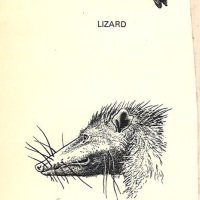African Arts
 From the UCLA African Arts homepage:
From the UCLA African Arts homepage:
“African Arts presents original research and critical discourse on traditional, contemporary, and popular African arts and expressive cultures. Since 1967, the journal has reflected the dynamism and diversity of several fields of humanistic study, publishing richly illustrated articles in full color, incorporating the most current theory, practice, and intercultural dialogue.”
Utilizing raw materials like straw and palm fronds, the artists represented here display an uninhibited mastery of caricature. They distort the literal human image with a sense of humor and playfulness into an iconic and sometimes frightening archetype.
Our current holdings of African Arts begin in 1976. Here are some selections from the earlier issues:

African Arts, Volume XI, Issue Number 02. January 1978.
“The Dan Masker zakpai ga from Gpapolulo. Its main function is to insure that women have put out their fires every noon during the dry season before the potentially dangerous afternoon winds begin to blow.”
Photo by Eberhard and Barbara Fischer.

 African Arts, Volume XI, Issue Number 02. January 1978.
African Arts, Volume XI, Issue Number 02. January 1978.
Traditional Ndebele Beadwork.
Top Left: “A woman wearing her mapoto stands before the brightly colored murals of her house.”
Top Right: “An elderly woman wearing a Linaga decorated with a broad strip of small white beads. It has designs in the traditional red-blue-green-orange color combination.”
Bottom Right: “A maiden poses with her mother’s magnificently beaded blanket. The predominance of blue, green and black beads indicates its recent vintage.”
Photos by Suzanne Priebatsch & Natalie Knight.

African Arts, Volume X, Issue Number 02. January 1977.
“Birthday for African Arts and the united States Bicentennial.” Tito Zungu, South Africa. Ballpoint pen and koki pen on paper. 20 cm x 25 cm.

African Arts, Volume X, Issue Number 02. January 1977.
Right: “Flower composition between door and window painted to represent formalized leaves. Xhosa, near Assegai Bush, Cape Province.”
Left: “Litema motif. Sotho, near Kroonstad, orange free state.”

African Arts, Volume XI, Issue Number 03. April 1978.
“The idean lyawo, described by some as reprseenting a bride or wife, who exudes quiet dignity and refinement in her dance and costume. Her body is enveloped in folds of costly fabric, and her elaborate hairstyle is bedecked with silver and gold. Iyawo’s facial features are rendered in appliqued red cloth bisected by shiny zippers.”
IIaro, Nigeria.
Photo: Henry John Drewal.

African Arts, Volume XI, Issue Number 03. April 1978.
Egungun (masked figures)
Ikenne, Nigeria.
Photos: Klindt Houlberg.

African Arts, Volume XX, Issue Number 01. October 1986.
Right: Masquerades at the Ebi-Woro Festival. Ijebu, 1982.
Photos: Henry John Drewal.
Posted on August 5, 2013, in Art (Periodicals), Periodicals and tagged africa, african, african art, african arts, ceremony, cereomonies, costume, costumes, craft, crafts, dance, folk art, mami wata, mami wata shrine, mask, masks, Nigeria, Nigerian, periodical, periodicals, publication, publications, shrine, shrines, tradition, traditional, tribe, tribes, UCLA. Bookmark the permalink. Leave a comment.








Leave a comment
Comments 0